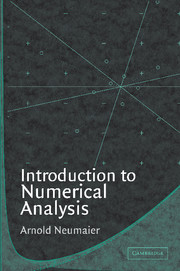3 - Interpolation and Numerical Differentiation
Published online by Cambridge University Press: 20 May 2010
Summary
In this chapter, we discuss the problem of finding a “nice” function of a single variable that has given values at specified points. This is the so-called interpolation problem. It is important both as a theoretical tool for the derivation and analysis of other numerical algorithms (e.g., finding zeros of functions, numerical integration, solving differential equations) and as a means to approximate functions known only at a finite set of points.
Because a continuous function is not uniquely defined by a finite number of function values, one must specify in advance a class of interpolation functions with good approximation properties. The simplest class, polynomials, has considerable theoretical importance; they can approximate any continuous functions in a bounded interval with arbitrarily small error. However, they often perform poorly when used to match many function values at specific (e.g., equally spaced) points over a wide interval because they tend to produce large spurious oscillations near the ends of the interval in which the data are given. Hence polynomials are used only over narrow intervals, and large intervals are split into smaller ones on which polynomials perform well. This results in interpolation by piecewise polynomials, and indeed, the most widely used interpolation schemes today are based on so-called splines – that is, piecewise polynomials with strong smoothness properties.
In Section 3.1, we discuss the basic properties of polynomial interpolation, including a discussion of its limitations.
Information
- Type
- Chapter
- Information
- Introduction to Numerical Analysis , pp. 130 - 178Publisher: Cambridge University PressPrint publication year: 2001
